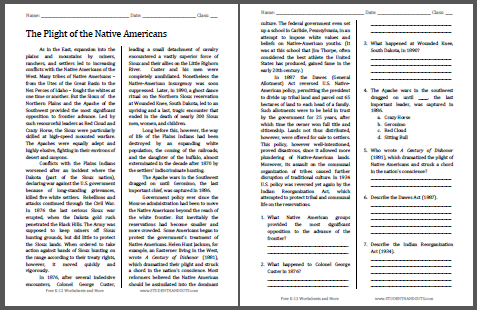| Plight of the Native Americans Reading with Questions |
|---|
| www.studenthandouts.com ↣ American History ↣ American History Readings with Questions |
As in the East, expansion into the plains and mountains by miners, ranchers, and settlers led to increasing conflicts with the Native Americans of the West. Many tribes of Native Americans – from the Utes of the Great Basin to the Nez Perces of Idaho – fought the whites at one time or another. But the Sioux of the Northern Plains and the Apache of the Southwest provided the most significant opposition to frontier advance. Led by such resourceful leaders as Red Cloud and Crazy Horse, the Sioux were particularly skilled at high-speed mounted warfare. The Apaches were equally adept and highly elusive, fighting in their environs of desert and canyons. Conflicts with the Plains Indians worsened after an incident where the Dakota (part of the Sioux nation), declaring war against the U.S. government because of long-standing grievances, killed five white settlers. Rebellions and attacks continued through the Civil War. In 1876 the last serious Sioux war erupted, when the Dakota gold rush penetrated the Black Hills. The Army was supposed to keep miners off Sioux hunting grounds, but did little to protect the Sioux lands. When ordered to take action against bands of Sioux hunting on the range according to their treaty rights, however, it moved quickly and vigorously. Conflicts with the Plains Indians worsened after an incident where the Dakota (part of the Sioux nation), declaring war against the U.S. government because of long-standing grievances, killed five white settlers. Rebellions and attacks continued through the Civil War. In 1876 the last serious Sioux war erupted, when the Dakota gold rush penetrated the Black Hills. The Army was supposed to keep miners off Sioux hunting grounds, but did little to protect the Sioux lands. When ordered to take action against bands of Sioux hunting on the range according to their treaty rights, however, it moved quickly and vigorously.In 1876, after several indecisive encounters, Colonel George Custer, leading a small detachment of cavalry encountered a vastly superior force of Sioux and their allies on the Little Bighorn River. Custer and his men were completely annihilated. Nonetheless the Native-American insurgency was soon suppressed. Later, in 1890, a ghost dance ritual on the Northern Sioux reservation at Wounded Knee, South Dakota, led to an uprising and a last, tragic encounter that ended in the death of nearly 300 Sioux men, women, and children. Long before this, however, the way of life of the Plains Indians had been destroyed by an expanding white population, the coming of the railroads, and the slaughter of the buffalo, almost exterminated in the decade after 1870 by the settlers' indiscriminate hunting. The Apache wars in the Southwest dragged on until Geronimo, the last important chief, was captured in 1886. Government policy ever since the Monroe administration had been to move the Native Americans beyond the reach of the white frontier. But inevitably the reservations had become smaller and more crowded. Some Americans began to protest the government's treatment of Native Americans. Helen Hunt Jackson, for example, an Easterner living in the West, wrote A Century of Dishonor (1881), which dramatized their plight and struck a chord in the nation's conscience. Most reformers believed the Native American should be assimilated into the dominant culture. The federal government even set up a school in Carlisle, Pennsylvania, in an attempt to impose white values and beliefs on Native-American youths. (It was at this school that Jim Thorpe, often considered the best athlete the United States has produced, gained fame in the early 20th century.) In 1887 the Dawes (General Allotment) Act reversed U.S. Native-American policy, permitting the president to divide up tribal land and parcel out 65 hectares of land to each head of a family. Such allotments were to be held in trust by the government for 25 years, after which time the owner won full title and citizenship. Lands not thus distributed, however, were offered for sale to settlers. This policy, however well-intentioned, proved disastrous, since it allowed more plundering of Native-American lands. Moreover, its assault on the communal organization of tribes caused further disruption of traditional culture. In 1934 U.S. policy was reversed yet again by the Indian Reorganization Act, which attempted to protect tribal and communal life on the reservations. Click here to print. Answer Key: (1) Sioux of the Northern Plains and Apache of the Southwest; (2) He led a small detachment of cavalry and encountered a vastly superior force of Sioux and their allies on the Little Bighorn River; Custer and his men were completely annihilated; (3) A ghost dance ritual on the Northern Sioux reservation led to an uprising and the massacre of nearly 300 Sioux men, women, and children; (4) B - Geronimo; (5) Helen Hunt Jackson; (6) Reversed U.S. Native -American policy, permitting the president to divide up tribal land and parcel out 65 hectares of land to each head of a family; allotments held in trust by the government for 25 years; lands not distributed were offered up for sale to settlers; (7) Reversal of U.S. Native-American policy; attempted to protect tribal and communal life on the reservations. |
 |  |  |  |  |
| www.studenthandouts.com ↣ American History ↣ American History Readings with Questions |








